Stormy weather can wreak havoc on fences, often leaving them in such a state that they need to be completely replaced.
It can be tricky to figure out who should foot the bill for repairs, but fencing experts at Jacksons Fencing have shared some tips on how to suss out who owns which side of the fence.
The first clue is to check who has the “good side” of the fence. While it’s not a definitive answer, it’s a useful indicator. The experts explained: “Typically, you can guess who owns a fence by seeing where the rails are, with the fence typically facing away from their property so that their neighbour gets the ‘good’ side of the fence.
“This is the most secure way of facing fencing so there are no rails for anyone to use to climb into your garden. This is then repeated with the neighbour on the other side to ensure that each home has both a ‘good’ and ‘bad’ fence side.”
However, it’s not a legal requirement for your neighbour to have the good side of the fence, meaning both sides could look identical. In such instances, it’s best to consult the legal documents that outline property boundaries, , reports the Express.
The experts added: “Contrary to common belief, there is not a designated side of the fence to each property. The only way to know for certain who owns what side is to refer to the Title Plan or Land Registry. In this, the ‘T’ mark is used to indicate who the boundary belongs to and therefore who is responsible for its upkeep.”
The experts at Jacksons Fencing have revealed a handy tip for homeowners: if a ‘T’ mark appears on both sides of your fence, forming an ‘H’, it’s a shared responsibility. This type of boundary is known as a “party wall” or a “party fence”, and it means that both neighbours are responsible for its upkeep.
However, while walls on the boundary of two properties fall under the Party Wall Act, regular garden fences don’t. Sometimes, the boundaries in your documents might be out of date, which can lead to confusion over who owns what.
This could occur if the boundary has been changed since the documents were created, or if neighbours have encroached on your land without realising. If you suspect the boundary is wrong, the fencing pros suggest checking with the Land Registry to clarify fence ownership.
They also warn: “Frustratingly, there is no way to make your neighbour repair their fence, even if it is rotting and making your garden look unsightly.”
And if you’re thinking about hiring a disputes expert, remember it counts as an official dispute and must be declared when selling your property. The alternative? Put up your own fence within your boundary, right next to the existing one.
Get email updates with the day’s biggest stories

